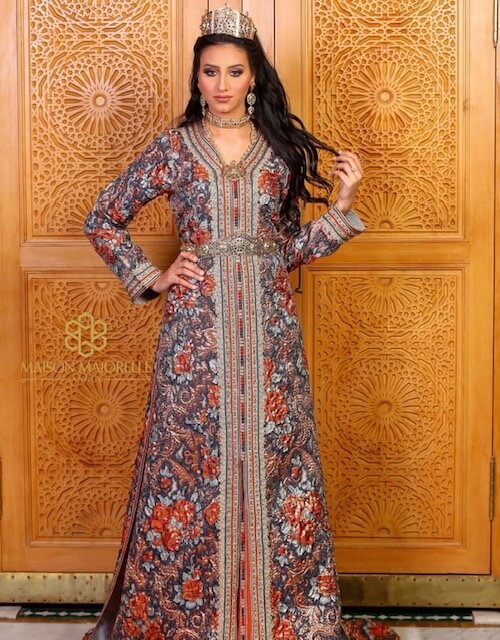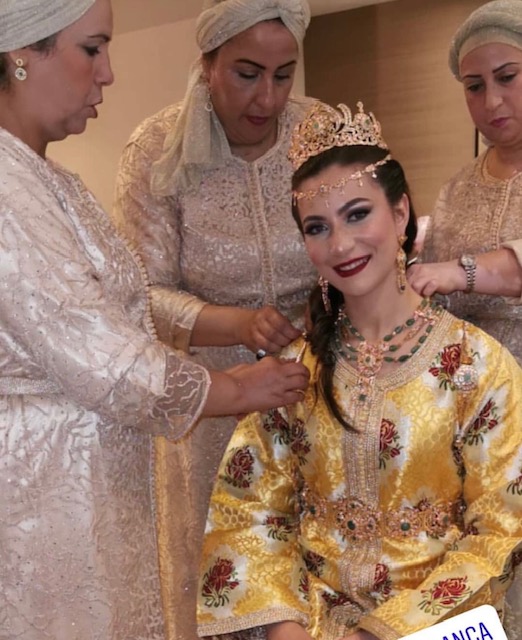
The Moroccan Kaftan or Caftan has lent itself to fashion all throughout the dynasties and continents.
This staple garment as we know it has played a key role in the dressing of sultans, generals, and noblewomen for many centuries.
The true origins or perhaps even the genesis of this garment are shrouded in mystery.
Some claim it belongs to the Ottoman Empire (based on the appellation), while others attribute it to Moroccan, West African, or even Asian cultures
Some links below may be affiliate links. As an Amazon Associate I earn from qualifying purchases.
Table of Contents
Moroccan Kaftan through the years
At first, Moroccan Kaftan was entirely reserved for the royal family. Only the kings of the Marinid dynasty sported these tunics tailored by Moroccan “Maalem”s (cloth makers).
On some occasions, they would send kaftans crafted from brocade to Ottoman Sultans upon their coronation. This form of dress will later become the norm during the Saadian dynasty.
Nowadays, the traditional Moroccan Kaftan is a one-piece dress made from silk, wool, cotton, velvet, or even synthetic fabrics, and exclusively worn by women.
This dress typically comes with a belt, either in matching fabric or made from skali (metal thread) in silver or gold.
Different styles and designs of Moroccan kaftan
Moroccan traditional kaftan has managed to acquire global renown for its elegant effortlessness and glamour.
In fact, it has been featured in haute couture fashion collections from upscale brands like Yves Saint Laurent, Balenciaga, and Christian Dior -to name a few.
The Moroccan Kaftan with its tags and attributes will keep shifting worldwide until way past the previous decade.
From exotic and bohemian wear to high fashion and jet-set back to the orientalist fad and right into being associated with resort and cruise attire.
Besides the Western and European assessment of the Kaftan’s evolution through the decades, this garment’s progression in Morocco is a different kind of story.
Here, we invoke critically acclaimed fashion designers Naeem Khan and Elie Saab for staying as true to the Moroccan Kaftan’s image as possible.
Their complex one-piece and two-piece dresses with elaborate detailing and intricate embroidery have brought this garment to red carpets and beyond.
Within Morocco, each region has adopted the Kaftan’s minimalistic silhouette into the crafting of something more sophisticated and reflective of the region’s customs and traditions.
Accordingly, this branching out has resulted in three main divergences regarding the stylistic choices of this
The Kaftan of Tetouan
First, we account for the Kaftan of Tetouan (chamali). This northern kaftan is one of the most popular designs, it also makes several appearances in the paintings of orientalist artists like Louis Auguste Girardot.
Since Tangier and Tetouan were one of the most accessible cities and welcoming cities, foreigners and tourists were mesmerized by their architecture, customs, and clothing.
The Tetouan Kaftan is very large and flares toward the bottom, it has wide three-quarter sleeves and is typically worn with pants or seroual and a vest called bed’iyah.
It’s usually made from silk or brocade and features repetitive motifs, namely artisanal-looking daggers or khanjar.
The Kaftan of Rabat
The Kaftan of Rabat is primarily made from velvet and thick velour. Unlike its northern counterpart, this kaftan is very narrow and carries well under other traditional clothing like djellabas for instance.
The cut is very close to one’s body shape, and the embroidery is usually done with gold stitching.
As for the color scheme, Rbati kaftans consist of a darker and cooler color palette compared to other garments. The main ones being blue, green, violet, or burgundy.
The embroidery is reminiscent of that found in ceremonial dresses that Moroccan Jewish women used to wear in the 40s and 50s.
The Kaftan of Fez
The ancient and aristocratic city of Fez is known for its abundance of textiles, proficient craftsmen, and creative artists. Up until the late 60s and 70s, this city has always been known as the capital of art, culture, and fashion in all of Morocco.
Any aspiring fashion designer strived to learn the art of cloth making from the old Fassi maalems. So Fez played a major role in shaping the contemporary kaftans of today.
Traditional Fassi kaftans were made from all kinds of fabrics and embroidered in numerous manners, though always preserving the standard “T shape” of the garment.
Widely popular for its handwoven brocade kaftans such as Khrib, Deniajat, Bahja…
But also its velour kaftans called Qaftane Nta’a (this gets its name from the style of embroidery that goes by the same name -Tarz Nta’a), as well as Qaftane Tarz Lam’allem (also gets its name from the style of embroidery).
These embroideries were typically done by Jewish artisans in different shapes (such as peacock), some of which we also find in traditional Moroccan jewelry.
Where to buy Moroccan Kaftan
The Moroccan Kaftan has managed to preserve its ancestral roots, namely the know-hows of weaving, embroidery, gold and silver thread work, as well as the art of beading.
Though the shape of the Kaftan has changed from loose and flared to a closer more fitting cut, the essence of this garment remains unchanged.
Contemporary Moroccan fashion designers still incorporate many of the intricacies of sewing and cloth-assembling that their forefathers have left as a legacy.
Nowadays, the Moroccan Kaftan has become a modern, elegant, easy-to-wear yet luxurious garment that’s symbolic of opulence and prestige all the same.
If you’re interested in acquiring one for yourself, you might wanna take a stroll down the souks and the medinas of Morocco for an authentic Moroccan Kaftan. Fez is your go-to city for some Kaftan shopping.
If the souk scene is too much for you, you can visit Diamantine’s stores in any Moroccan mall or shopping center. They have anything from Djellabas and Jabadors to Kaftans, Takchitas, and even scarves.
Discover the Perfect Kaftan!
Elevate your style with this exquisite collection of Moroccan Kaftans.
If you’re looking for a more relaxed and casual Kaftan (for everyday use), you might like this beach dress-esque caftan in blue or white.
For more special kaftans, there’s this purple one embroidered in gold: this style is known as farasha or butterfly since the sleeves are entirely open.
Though if you want to stay as true to the Moroccan kaftan as possible, this green and silver kaftan retains that traditional and authentic look.


